使用 dynamic 类型让 ASP.NET Core 实现 HATEOAS 结构的 RESTful API
Posted dotNET跨平台
tags:
篇首语:本文由小常识网(cha138.com)小编为大家整理,主要介绍了使用 dynamic 类型让 ASP.NET Core 实现 HATEOAS 结构的 RESTful API相关的知识,希望对你有一定的参考价值。
使用dynamic (ExpandoObject)的好处就是可以动态组建返回类型, 之前使用的是ViewModel, 如果想返回结果的话, 肯定需要把ViewModel所有的属性都返回, 如果属性比较多, 就有可能造成性能和灵活性等问题. 而使用ExpandoObject(dynamic)就可以解决这个问题.
返回一个对象
返回一个dynamic类型的对象, 需要把所需要的属性从ViewModel抽取出来并转化成dynamic对象, 这里所需要的属性通常是从参数传进来的, 例如针对下面的CustomerViewModel类, 参数可能是这样的: "Name, Company":
using System;
using SalesApi.Core.Abstractions.DomainModels;
namespace SalesApi.ViewModels
{
public class CustomerViewModel: EntityBase
{
public string Company { get; set; }
public string Name { get; set; }
public DateTimeOffset EstablishmentTime { get; set; }
}
}
还需要一个Extension Method可以把对象按照需要的属性转化成dynamic类型:
using System;
using System.Collections.Generic;
using System.Dynamic;
using System.Reflection;
namespace SalesApi.Shared.Helpers
{
public static class ObjectExtensions
{
public static ExpandoObject ToDynamic<TSource>(this TSource source, string fields = null)
{
if (source == null)
{
throw new ArgumentNullException("source");
}
var dataShapedObject = new ExpandoObject();
if (string.IsNullOrWhiteSpace(fields))
{
// 所有的 public properties 应该包含在ExpandoObject里
var propertyInfos = typeof(TSource).GetProperties(BindingFlags.IgnoreCase | BindingFlags.Public | BindingFlags.Instance);
foreach (var propertyInfo in propertyInfos)
{
// 取得源对象上该property的值
var propertyValue = propertyInfo.GetValue(source);
// 为ExpandoObject添加field
((IDictionary<string, object>)dataShapedObject).Add(propertyInfo.Name, propertyValue);
}
return dataShapedObject;
}
// field是使用 "," 分割的, 这里是进行分割动作.
var fieldsAfterSplit = fields.Split(',');
foreach (var field in fieldsAfterSplit)
{
var propertyName = field.Trim();
// 使用反射来获取源对象上的property
// 需要包括public和实例属性, 并忽略大小写.
var propertyInfo = typeof(TSource).GetProperty(propertyName, BindingFlags.IgnoreCase | BindingFlags.Public | BindingFlags.Instance);
if (propertyInfo == null)
{
throw new Exception($"没有在‘{typeof(TSource)}’上找到‘{propertyName}’这个Property");
}
// 取得源对象property的值
var propertyValue = propertyInfo.GetValue(source);
// 为ExpandoObject添加field
((IDictionary<string, object>)dataShapedObject).Add(propertyInfo.Name, propertyValue);
}
return dataShapedObject;
}
}
}
注意: 这里的逻辑是如果没有选择需要的属性的话, 那么就返回所有合适的属性.
然后在CustomerController里面:
首先创建为对象添加link的方法:
private IEnumerable<LinkViewModel> CreateLinksForCustomer(int id, string fields = null)
{
var links = new List<LinkViewModel>();
if (string.IsNullOrWhiteSpace(fields))
{
links.Add(
new LinkViewModel(_urlHelper.Link("GetCustomer", new { id = id }),
"self",
"GET"));
}
else
{
links.Add(
new LinkViewModel(_urlHelper.Link("GetCustomer", new { id = id, fields = fields }),
"self",
"GET"));
}
links.Add(
new LinkViewModel(_urlHelper.Link("DeleteCustomer", new { id = id }),
"delete_customer",
"DELETE"));
links.Add(
new LinkViewModel(_urlHelper.Link("CreateCustomer", new { id = id }),
"create_customer",
"POST"));
return links;
}
针对返回一个对象, 添加了本身的连接, 添加的连接 以及 删除的连接.
然后修改Get和Post的Action:
[HttpGet]
[Route("{id}", Name = "GetCustomer")]
public async Task<IActionResult> Get(int id, string fields)
{
var item = await _customerRepository.GetSingleAsync(id);
if (item == null)
{
return NotFound();
}
var customerVm = Mapper.Map<CustomerViewModel>(item);
var links = CreateLinksForCustomer(id, fields);
var dynamicObject = customerVm.ToDynamic(fields) as IDictionary<string, object>;
dynamicObject.Add("links", links);
return Ok(dynamicObject);
}
[HttpPost(Name = "CreateCustomer")]
public async Task<IActionResult> Post([FromBody] CustomerViewModel customerVm)
{
if (customerVm == null)
{
return BadRequest();
}
if (!ModelState.IsValid)
{
return BadRequest(ModelState);
}
var newItem = Mapper.Map<Customer>(customerVm);
_customerRepository.Add(newItem);
if (!await UnitOfWork.SaveAsync())
{
return StatusCode(500, "保存时出错");
}
var vm = Mapper.Map<CustomerViewModel>(newItem);
var links = CreateLinksForCustomer(vm.Id);
var dynamicObject = vm.ToDynamic() as IDictionary<string, object>;
dynamicObject.Add("links", links);
return CreatedAtRoute("GetCustomer", new { id = dynamicObject["Id"] }, dynamicObject);
}
红色部分是相关的代码. 创建links之后把vm对象按照需要的属性转化成dynamic对象. 然后往这个dynamic对象里面添加links属性. 最后返回该对象.
下面测试一下.
POST:
结果:
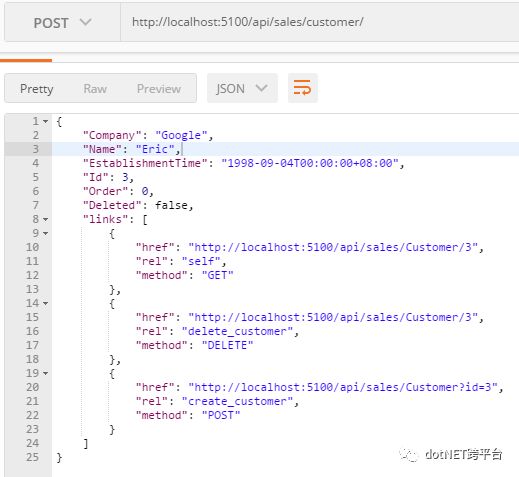
由于POST方法里面没有选择任何fields, 所以返回所有的属性.
下面试一下GET:
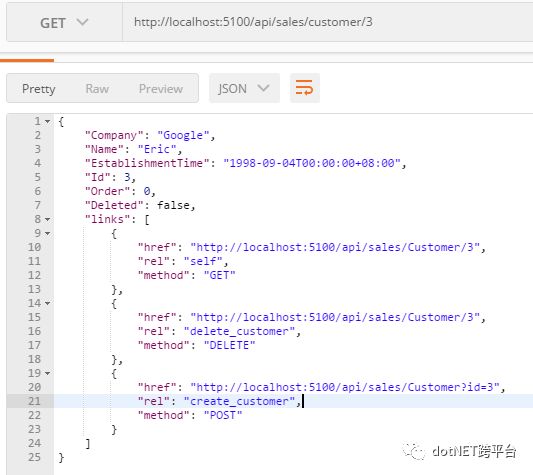
再试一下GET, 选择几个fields:

OK, 效果都如预期.
但是有一个问题, 因为返回的json的Pascal case的(只有dynamic对象返回的是Pascal case, 其他ViewModel现在返回的都是camel case的), 而camel case才是更好的选择 .
所以在Startup里面可以这样设置:
services.AddMvc(options =>
{
options.ReturnHttpNotAcceptable = true;
// the default formatter is the first one in the list.
options.OutputFormatters.Remove(new XmlDataContractSerializerOutputFormatter());
// set authorization on all controllers or routes
var policy = new AuthorizationPolicyBuilder()
.RequireAuthenticatedUser()
.Build();
options.Filters.Add(new AuthorizeFilter(policy));
})
.AddJsonOptions(options =>
{
options.SerializerSettings.ContractResolver = new CamelCasePropertyNamesContractResolver();
})
.AddFluetValidations();
然后再试试:
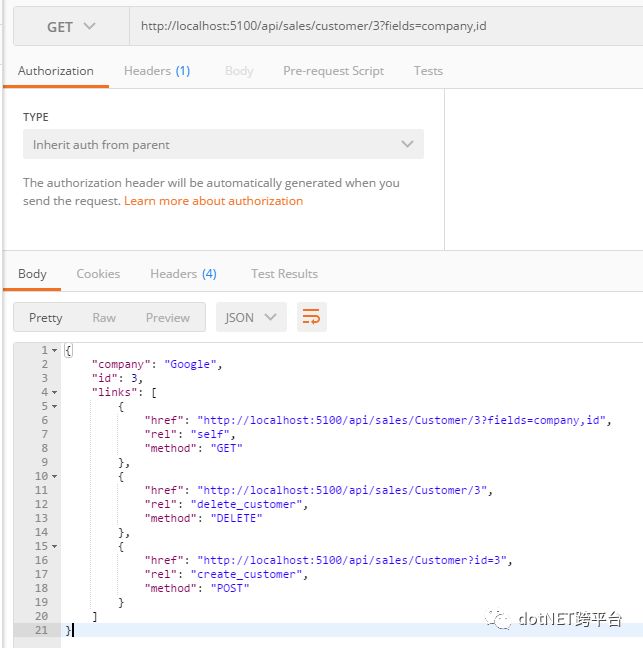
OK.
返回集合
首先编写创建links的方法:
private IEnumerable<LinkViewModel> CreateLinksForCustomers(string fields = null)
{
var links = new List<LinkViewModel>();
if (string.IsNullOrWhiteSpace(fields))
{
links.Add(
new LinkViewModel(_urlHelper.Link("GetAllCustomers", new { fields = fields }),
"self",
"GET"));
}
else
{
links.Add(
new LinkViewModel(_urlHelper.Link("GetAllCustomers", new { }),
"self",
"GET"));
}
return links;
}
这个很简单.
然后需要针对IEnumerable<T>类型创建把ViewModel转化成dynamic对象的Extension方法:
using System;
using System.Collections.Generic;
using System.Dynamic;
using System.Reflection;
namespace SalesApi.Shared.Helpers
{
public static class IEnumerableExtensions
{
public static IEnumerable<ExpandoObject> ToDynamicIEnumerable<TSource>(this IEnumerable<TSource> source, string fields)
{
if (source == null)
{
throw new ArgumentNullException("source");
}
var expandoObjectList = new List<ExpandoObject>();
var propertyInfoList = new List<PropertyInfo>();
if (string.IsNullOrWhiteSpace(fields))
{
var propertyInfos = typeof(TSource).GetProperties(BindingFlags.Public | BindingFlags.Instance);
propertyInfoList.AddRange(propertyInfos);
}
else
{
var fieldsAfterSplit = fields.Split(',');
foreach (var field in fieldsAfterSplit)
{
var propertyName = field.Trim();
var propertyInfo = typeof(TSource).GetProperty(propertyName, BindingFlags.IgnoreCase | BindingFlags.Public | BindingFlags.Instance);
if (propertyInfo == null)
{
throw new Exception($"Property {propertyName} wasn't found on {typeof(TSource)}");
}
propertyInfoList.Add(propertyInfo);
}
}
foreach (TSource sourceObject in source)
{
var dataShapedObject = new ExpandoObject();
foreach (var propertyInfo in propertyInfoList)
{
var propertyValue = propertyInfo.GetValue(sourceObject);
((IDictionary<string, object>)dataShapedObject).Add(propertyInfo.Name, propertyValue);
}
expandoObjectList.Add(dataShapedObject);
}
return expandoObjectList;
}
}
}
注意: 反射的开销很大, 注意性能.
然后修改GetAll方法:
[HttpGet(Name = "GetAllCustomers")]
public async Task<IActionResult> GetAll(string fields)
{
var items = await _customerRepository.GetAllAsync();
var results = Mapper.Map<IEnumerable<CustomerViewModel>>(items);
var dynamicList = results.ToDynamicIEnumerable(fields);
var links = CreateLinksForCustomers(fields);
var dynamicListWithLinks = dynamicList.Select(customer =>
{
var customerDictionary = customer as IDictionary<string, object>;
var customerLinks = CreateLinksForCustomer(
(int)customerDictionary["Id"], fields);
customerDictionary.Add("links", customerLinks);
return customerDictionary;
});
var resultWithLink = new {
Value = dynamicListWithLinks,
Links = links
};
return Ok(resultWithLink);
}
红色部分是相关代码.
测试一下:
不选择属性:
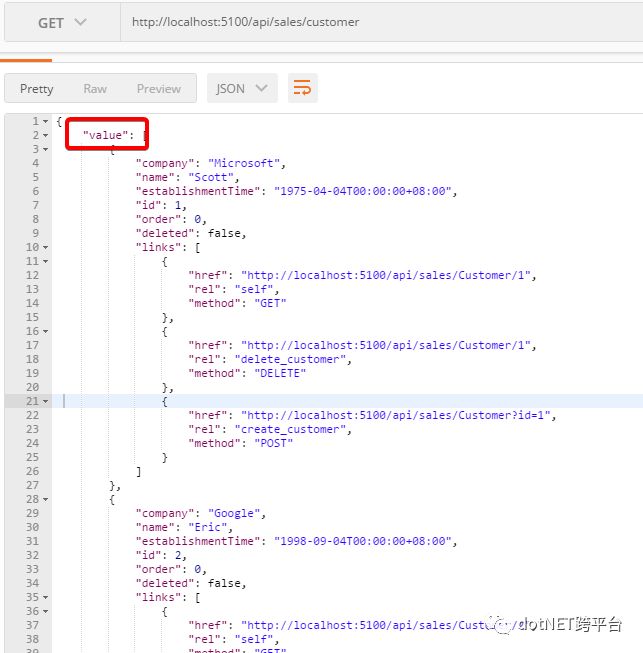
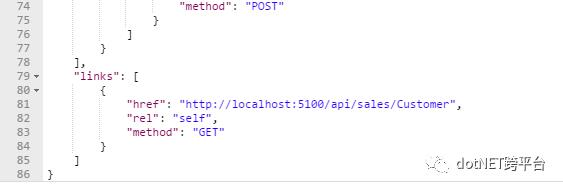
选择部分属性:
OK.
HATEOAS这部分就写到这.
其实 翻页的逻辑很适合使用HATEOAS结构. 有空我再写一个翻页的吧.
以上是关于使用 dynamic 类型让 ASP.NET Core 实现 HATEOAS 结构的 RESTful API的主要内容,如果未能解决你的问题,请参考以下文章
Asp.net mvc基础Controller给View传递数据的方式